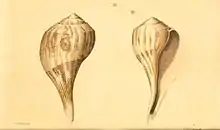Lucy Say
Lucy Way Sistare Say (November 28, 1800 – November 15, 1886) was an American naturalist and scientific artist. Say illustrated and colored 66 of 68 plates which became American Conchology, a depiction of the North American mollusks collected by her husband, Thomas Say, during his expeditions in North America. Lucy Say became the first female member of the Academy of Natural Sciences of Philadelphia (ANSP) on October 26, 1841.[1]
Lucy Way Sistare Say | |
|---|---|
| Born | November 28, 1800 New London, Connecticut |
| Died | November 15, 1886 (aged 85) |
| Nationality | American |
| Known for | nature art |
Notable work | American Conchology |
Early life and education
Born in New London, Connecticut, Lucy Way Sistare Say was one of ten children born to Joseph and Nancy Way Sistare. Her first known education was at a Pestalozzian girls school in Philadelphia, operated by Marie Duclos Fretageot.[2] She studied illustration under French naturalist and illustrator Charles Alexandre Lesueur and John James Audubon.[3] She met her future husband, Thomas Say, through other artists and naturalists at the Fretageot school.[1][4]
Career
While in Philadelphia, Lucy Say became acquainted with many other naturalists, including some of the founders of the Academy of Natural Sciences. She joined a group of prominent scientists, educators, and artists on a keelboat known as "Boatload of Knowledge," which traveled along the Ohio River from Pittsburgh, Pennsylvania during the winter of 1825-1826 to form a utopian socialist community in New Harmony, Indiana. During the voyage to New Harmony, she became acquainted with naturalist Thomas Say and they married on January 4, 1827.
Lucy Say taught illustration in New Harmony while her husband carried out scientific research expeditions; notable students include David Dale Owen and Richard Owen, Indiana's first and third state geologists. Due to the frontier nature of the town, and especially from the liberal views supporting equality of the sexes advocated by community leaders Robert Owen and William Maclure, women faced fewer social restrictions in New Harmony than in eastern cities. When Say returned to New York City in 1834 following her husband's death, she described her new life in the east as "too circumscribed, I long for the freedom I used to enjoy when I lived on the Banks of the Wabash".[1]
Say's drawing and painting skills were applied in earnest when she undertook to illustrate Thomas's monographic work, American Conchology.[5] Besides furnishing drawings for 66 of the work's 68 plates, Say performed much of the painstaking coloring of individual impressions, which came to number in the thousands. She was assisted in this task by two of engraver Cornelius Tiebout's children, Henry and Caroline. R.E. Banta wrote, in 1938, that these colored plates "surpass anything else produced in this country [at that time] in delicacy and accuracy of detail. Each shell is a masterpiece of miniature painting which, apparently, involved hours of labor." After her husbands death Say began to undertake the engraving of her plates herself.[4]
Say devoted her remaining years to aiding the natural sciences and maintaining her late husband's reputation. She donated his entomological collection and library to the ANSP. In 1840, Say began a correspondence with Samuel Stehman Haldeman (1812-1880), whom she viewed as a capable successor to her husband's research in conchology and entomology. She formed a small cabinet of her own and exchanged shell specimens with Haldeman. As part of Say's recognition by the world of science, she was elected the first female member of the ANSP on 26 October 1841 and a member of its Conchological Section in 1868.[6] She died in 1886.[4]
References
- "Lucy Say Illustrations". Academy of Natural Sciences of Philadelphia. Retrieved 2013-04-09.
- "Lucy Way Sistare Say". Journal of the Sierra College Natural History Museum. 5 (1). 2015.
- "Lucy Say – Conservation Heritage". paconservationheritage.org. Retrieved 2020-09-06.
- Stroud, Patricia Tyson (February 2013). ""At What do you Think the Ladies will Stop?" Women at the Academy". Proceedings of the Academy of Natural Sciences of Philadelphia. 162 (1): 195–206. doi:10.1635/053.162.0116. ISSN 0097-3157. S2CID 191701294.
- "Say's Creative Process". American Philosophical Society. Retrieved 2020-09-06.
- "Say, Lucy Way Sistare, 1801-1886". Purdue University, Archives and Special Collections. 2020. Retrieved 5 September 2020.
External links
| Wikimedia Commons has media related to Lucy Say. |
